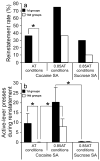Cue-induced reinstatement of cocaine seeking in the rat "conflict model": effect of prolonged home-cage confinement
- PMID: 21792542
- PMCID: PMC3260342
- DOI: 10.1007/s00213-011-2416-z
Cue-induced reinstatement of cocaine seeking in the rat "conflict model": effect of prolonged home-cage confinement
Abstract
Rationale and objectives: Drug addiction is not just the repeated administration of drugs, but compulsive drug use maintained despite the accumulation of adverse consequences for the user. In an attempt to introduce adverse consequences of drug seeking to laboratory animals, we have developed the "conflict model," in which the access of rats to a reinforcing lever allowing self-administration requires passing of an electrified grid floor. In this model, the current intensity leading to complete abstinence from drug seeking can be measured individually. The present study was designed to evaluated whether reinstatement of drug or natural reward seeking, despite the presence of the electrical barrier, can be achieved by presentation of discrete cues that were associated with the reward, and whether prolonged home-cage confinement can facilitate such reinstatement in this model.
Methods: The "conflict model" was used to test cue-induced reinstatement in the presence of the electrical barrier, after 1 or 14 days of home-cage confinement, in groups of rats that were previously trained to self-administer cocaine or sucrose.
Results: Although similar shock intensity was required to suppress sucrose or cocaine self-administration, subjects exhibited significantly lower response to sucrose-associated as compared to cocaine-associated cues, during the reinstatement test. Importantly, cue-induced reinstatement of cocaine seeking was attenuated following 14 days of home-cage confinement.
Conclusions: The incorporation of aversive consequence in the self-administration model enable detection of what can be interpreted as a compulsive component unique to drug reinforcers. Moreover, the effect of the aversive consequence seems to increase following home-cage confinement.
Conflict of interest statement
The authors declare no conflicts of interests.
Figures




References
-
- Anker AL, Crowley TJ. Use of contingency contracts in specialty clinics for cocaine abuse. NIDA Res Monogr. 1982;41:452–9. - PubMed
-
- APA. Diagnostic and statistical manual of mental disorders. 4. American Psychiatric Association, American Psychiatric Association; 2000.
-
- Bigelow GE, Rand CS, Gross J, Burling TA, Gottlieb SH. Smoking cessation and relapse among cardiac patients. NIDA Res Monogr. 1986;72:167–71. - PubMed
-
- Bindra D, Cameron L. Changes in experimentally produced anxiety with the passage of time: incubation effect. J Exp Psychol. 1953;45:197–203. - PubMed
Publication types
MeSH terms
Substances
Grants and funding
LinkOut - more resources
Full Text Sources

